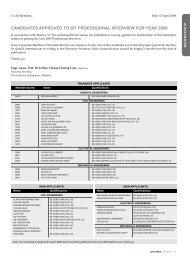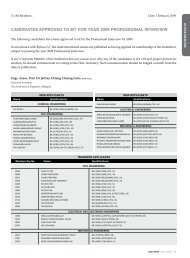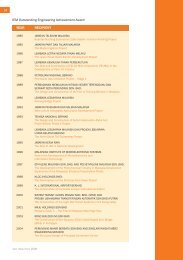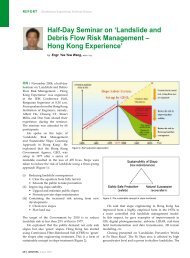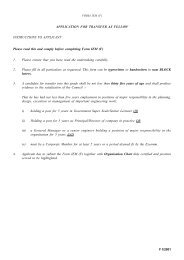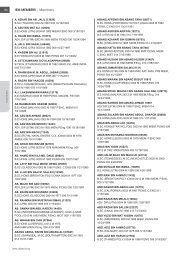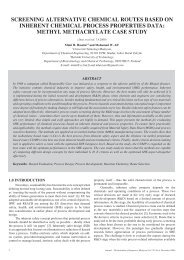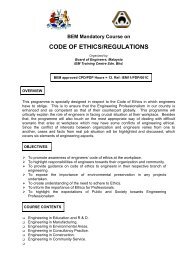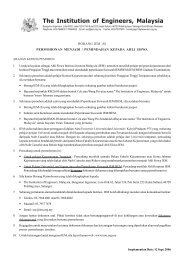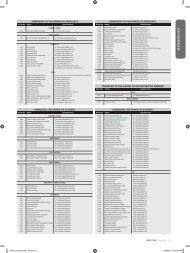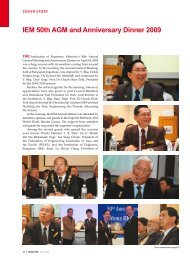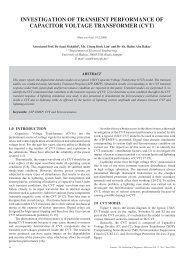Oil and Gas Industry in Malaysia - Institution of Engineers Malaysia
Oil and Gas Industry in Malaysia - Institution of Engineers Malaysia
Oil and Gas Industry in Malaysia - Institution of Engineers Malaysia
Create successful ePaper yourself
Turn your PDF publications into a flip-book with our unique Google optimized e-Paper software.
to produce any hydrocarbons<br />
discovered, <strong>and</strong> the actual<br />
production period.<br />
<strong>Malaysia</strong> has the 25th largest oil<br />
reserves <strong>and</strong> the 14th largest gas<br />
reserves <strong>in</strong> the world. The total<br />
reserves is <strong>of</strong> the order <strong>of</strong> 18.82<br />
billion barrels oil equivalent (boe),<br />
with a crude production rate <strong>of</strong> 600<br />
thous<strong>and</strong> barrels per day. The<br />
average natural gas production<br />
st<strong>and</strong>s at approximately 5.7 billion<br />
st<strong>and</strong>ard cubic feet per day.<br />
<strong>Malaysia</strong> has 494,183km 2 <strong>of</strong><br />
acreage available for oil <strong>and</strong><br />
gas exploration, with 337,167km 2 <strong>in</strong><br />
the <strong>of</strong>fshore cont<strong>in</strong>ental shelf area,<br />
<strong>and</strong> 63,968km 2 <strong>in</strong> deepwater. The<br />
acreage is split <strong>in</strong>to 54 blocks, out <strong>of</strong><br />
which 28 (a total <strong>of</strong> 205,500km 2 ) are<br />
currently operated by Petronas<br />
Carigali Sdn. Bhd. plus seven other<br />
mult<strong>in</strong>ational oil companies.<br />
<strong>Industry</strong> Players<br />
Among the PSC Contractors<br />
operat<strong>in</strong>g <strong>in</strong> <strong>Malaysia</strong> are Petronas<br />
Carigali (PETRONAS’s operations<br />
company), ExxonMobil Exploration<br />
<strong>and</strong> Production (<strong>Malaysia</strong>) Inc<br />
(EMEPMI), Nippon <strong>Oil</strong>, Sarawak<br />
Shell, Murphey <strong>Oil</strong> <strong>and</strong> Amarada<br />
Hess. These companies are <strong>in</strong>volved<br />
<strong>in</strong> upstream operations, which is<br />
generally understood to mean<br />
9<br />
JURUTERA, JANUARY 2005<br />
Figure 3: Historical Natural <strong>Gas</strong> Production<br />
all O&G activities tak<strong>in</strong>g place<br />
prior to process<strong>in</strong>g <strong>and</strong> ref<strong>in</strong><strong>in</strong>g<br />
<strong>of</strong> hydrocarbons. Among the<br />
activities would be:<br />
• Exploration: analys<strong>in</strong>g <strong>and</strong><br />
<strong>in</strong>terpret<strong>in</strong>g seismic data to<br />
determ<strong>in</strong>e the potential <strong>of</strong><br />
hydrocarbon reserves; drill<strong>in</strong>g <strong>of</strong><br />
test wells.<br />
• Conceptual development: perform<strong>in</strong>g<br />
screen<strong>in</strong>g studies to<br />
determ<strong>in</strong>e the most efficient <strong>and</strong><br />
cost effective method to produce<br />
potential hydrocarbon sources.<br />
This would <strong>in</strong>clude selection<br />
<strong>of</strong> facilities (float<strong>in</strong>g or<br />
moored structures), transport<br />
<strong>of</strong> hydrocarbon from field<br />
to customer (pipel<strong>in</strong>e, float<strong>in</strong>g<br />
storage <strong>and</strong> <strong>of</strong>fload<strong>in</strong>g (FSO)<br />
vessels), corrosion mitigation<br />
strategies, <strong>and</strong> safety aspects <strong>of</strong><br />
the operations.<br />
• Development: project management<br />
<strong>of</strong> construction, detailed<br />
eng<strong>in</strong>eer<strong>in</strong>g, optimum well<br />
location, transport <strong>of</strong> facilities<br />
to location <strong>and</strong> commission<strong>in</strong>g<br />
<strong>of</strong> facilities.<br />
• Production: ma<strong>in</strong>tenance strategies,<br />
plann<strong>in</strong>g budgets, analysis<br />
<strong>of</strong> supply <strong>and</strong> dem<strong>and</strong>, <strong>and</strong><br />
retr<strong>of</strong>it work to ma<strong>in</strong>ta<strong>in</strong> or meet<br />
new production targets.<br />
COVER STORY<br />
The O&G <strong>in</strong>dustry is <strong>in</strong>volved <strong>in</strong><br />
downstream activities as well. Here,<br />
‘downstream’ means processes<br />
tak<strong>in</strong>g place after oil has been<br />
transported from the reservoir, <strong>and</strong><br />
<strong>in</strong>to crude oil term<strong>in</strong>als. Investment<br />
opportunities <strong>in</strong>clude process<strong>in</strong>g<br />
<strong>and</strong> ref<strong>in</strong><strong>in</strong>g <strong>of</strong> the crude,<br />
petrochemical plants, logistics <strong>and</strong><br />
retail transactions. Downstream has<br />
different players, <strong>and</strong> a more<br />
diverse range <strong>of</strong> <strong>in</strong>terests. In<br />
oil ref<strong>in</strong><strong>in</strong>g, there are Petronas<br />
Penapisan (with plants <strong>in</strong><br />
Terengganu <strong>and</strong> Melaka), Shell,<br />
ExxonMobil <strong>and</strong> Conoco. Petronas<br />
<strong>Gas</strong> <strong>and</strong> MLNG are <strong>in</strong>volved <strong>in</strong> gas<br />
process<strong>in</strong>g <strong>and</strong> transmission. <strong>Gas</strong><br />
distribution is h<strong>and</strong>led by <strong>Gas</strong><br />
<strong>Malaysia</strong>. The retail arm has<br />
many <strong>in</strong>terests, <strong>in</strong>clud<strong>in</strong>g Petronas<br />
Dagangan, Shell, ExxonMobil<br />
<strong>and</strong> ConocoPhillips (under the<br />
Projet br<strong>and</strong>). Petrochemicals<br />
have the most diverse range<br />
<strong>of</strong> companies, <strong>in</strong>clud<strong>in</strong>g Optimal,<br />
BASF, BP, Amoco <strong>and</strong> Idemitsu.<br />
Challenges <strong>in</strong> the<br />
Upstream<br />
The Malay Bas<strong>in</strong> is a relatively<br />
mature location, with well-known<br />
hydrocarbon reserves. Therefore, a<br />
lot <strong>of</strong> work is <strong>in</strong> progress to<br />
<strong>in</strong>crease current production<br />
by improv<strong>in</strong>g the amount <strong>of</strong><br />
hydrocarbon recovered from<br />
exist<strong>in</strong>g sources <strong>and</strong> by f<strong>in</strong>d<strong>in</strong>g new<br />
reservoirs <strong>in</strong> areas that have<br />
been previously overlooked. New<br />
exploration <strong>and</strong> <strong>in</strong>terpretation <strong>of</strong><br />
data <strong>in</strong> currently produc<strong>in</strong>g regions<br />
have resulted <strong>in</strong> new f<strong>in</strong>ds. One f<strong>in</strong>d<br />
is the Sum<strong>and</strong>ak Complex, where<br />
oil is be<strong>in</strong>g found <strong>in</strong> regions<br />
previously thought to be devoid<br />
<strong>of</strong> hydrocarbons.<br />
In addition to explor<strong>in</strong>g old<br />
areas, new fields are be<strong>in</strong>g sought.<br />
One upcom<strong>in</strong>g production area is <strong>in</strong><br />
what is known as deep waters<br />
(water depth more than 1000ft or



